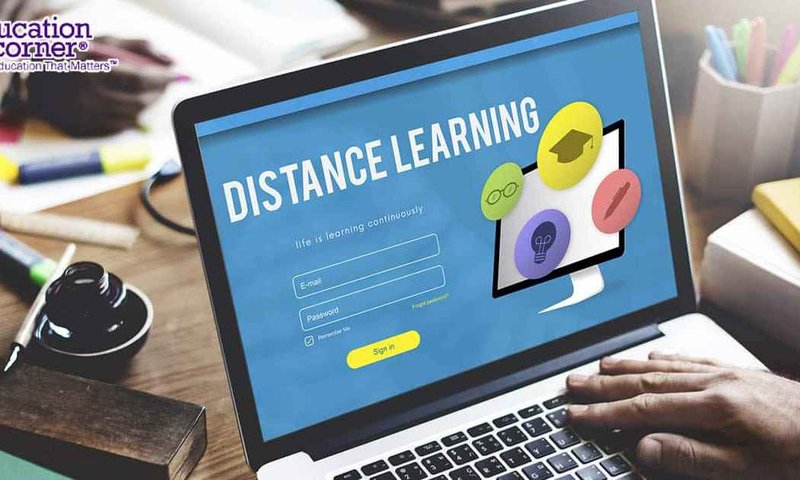From universities offering fully online degrees to corporate training programs and K-12 virtual classrooms, distance learning provides accessible, flexible, and personalized education for learners worldwide.
In this guide, we will explore:

- What is distance learning, and how does it work?
- Types of distance learning models.
- Benefits and challenges of remote education.
- The role of technology in online learning.
- Tips for success in a distance learning environment.
What is Distance Learning?
Distance learning refers to education where students and instructors are physically separated, relying on technology to facilitate teaching and interaction. It eliminates the need for a physical classroom, allowing students to learn from anywhere with an internet connection.
📌 Key Features of Distance Learning:
Online platforms and digital resources replace traditional textbooks and classrooms.
Asynchronous and synchronous learning allow for flexible schedules.
Virtual communication tools enable interaction between students and instructors.
📌 Example: A student in India can earn a degree from Harvard through online programs without ever setting foot on campus.
Types of Distance Learning Models
Distance learning comes in various formats, depending on the level of instructor involvement, real-time interaction, and flexibility.
1. Synchronous Learning (Live & Real-Time) 🕒
Students and instructors interact in real-time through live classes.
Requires scheduled sessions via video conferencing tools like Zoom or Microsoft Teams.
Promotes engagement through discussions, group projects, and Q&A sessions.
📌 Example: A university conducts a weekly virtual lecture for online students with a live Q&A session.
2. Asynchronous Learning (Self-Paced & Flexible) ⏳
Students learn at their own pace, accessing pre-recorded lectures and reading materials.
Does not require live interaction but includes discussion boards and email support.
Ideal for working professionals and students in different time zones.
📌 Example: A student completes a self-paced Udemy course on programming, watching lectures whenever convenient.
3. Hybrid or Blended Learning 🏫+💻
A mix of online and in-person instruction.
Combines the flexibility of distance learning with the structure of classroom sessions.
Used in higher education, corporate training, and professional certifications.
📌 Example: A university offers in-person labs and virtual lectures for science students.
4. MOOC (Massive Open Online Courses) 📚
Free or low-cost online courses accessible to anyone worldwide.
Offered by platforms like Coursera, edX, Khan Academy, and FutureLearn.
Provides certificates and degrees from top universities.
📌 Example: A student in Africa takes an AI course from Stanford University on Coursera.
5. Correspondence Courses (Offline Distance Learning) 📩
- Learning materials are sent via mail or email, and students submit assignments remotely.
- No real-time interaction with instructors.
- Used in rural areas with limited internet access.
📌 Example: A remote village school receives printed study materials for government distance education programs.
Benefits of Distance Learning ✅
1. Flexibility and Convenience ⏳
Learn anytime, anywhere, fitting studies around work and personal commitments.
Ideal for working professionals, parents, and international students.
2. Accessibility and Global Reach 🌍
Opens education to students from remote locations.
No need to relocate for a specific school or university.
3. Cost-Effective and Affordable 💰
Lower tuition fees compared to traditional universities.
Eliminates travel, accommodation, and textbook expenses.
Many free online courses available.
📌 Example: Harvard and MIT offer free online courses through edX.
4. Personalized Learning 🏆
Students can learn at their own pace.
Adaptive learning platforms adjust content based on performance and progress.
📌 Example: Duolingo personalizes language lessons based on user mistakes.
5. Career Advancement and Skill Development 🎓
Enables professionals to earn degrees while working full-time.
Short online courses improve job skills, leading to better career opportunities.
📌 Example: Google offers certificates in data science and UX design that help learners get hired.
Challenges of Distance Learning & How to Overcome Them
| Challenge | Solution |
|---|---|
| Lack of face-to-face interaction | Use discussion forums, virtual study groups, and live Q&A sessions. |
| Time management difficulties | Set a study schedule and use productivity tools like Trello or Google Calendar. |
| Technical issues (poor internet, software problems) | Ensure a stable internet connection and familiarize yourself with learning platforms. |
| Limited access to hands-on learning | Use simulated labs and virtual reality (VR) for practical subjects. |
| Motivation and self-discipline | Set clear goals, reward progress, and stay engaged with instructors and peers. |
📌 Pro Tip: Treat online learning like a physical class—stick to schedules, participate in discussions, and minimize distractions.
The Role of Technology in Distance Learning
Modern distance learning is powered by advanced digital tools and platforms that enhance accessibility and engagement.
1. Learning Management Systems (LMS) 📖
✔ Platforms like Moodle, Blackboard, and Google Classroom help manage coursework, assignments, and assessments.
2. Video Conferencing & Virtual Classrooms 🎥
✔ Tools like Zoom, Microsoft Teams, and Google Meet enable real-time lectures and discussions.
3. AI and Personalized Learning 🤖
✔ AI-powered platforms adapt content based on student performance.
📌 Example: Coursera and Udacity use AI to customize courses.
4. Virtual Labs & Simulations 🧪
✔ Platforms like Labster and PhET provide interactive science experiments.
5. Gamification & Interactive Learning 🎮
✔ Kahoot, Duolingo, and Quizlet use games and rewards to boost engagement.
Tips for Success in Distance Learning 🎯
- Create a Dedicated Study Space – Quiet, organized, and distraction-free.
- Set Clear Goals and a Study Schedule – Stick to deadlines and track progress.
- Engage Actively – Participate in forums, virtual discussions, and networking groups.
- Use Productivity Tools – Google Calendar, Evernote, and Trello help manage time.
- Take Regular Breaks – Use the Pomodoro technique for better focus.
📌 Best Practice: Stay proactive—ask questions, interact with peers, and seek support from instructors.
Conclusion: The Future of Distance Learning 🚀
Distance learning is no longer just an alternative to traditional education—it is the future of learning. With its flexibility, accessibility, and technological advancements, online education continues to break barriers and create opportunities for learners worldwide.
Whether you’re earning a degree, upskilling for a career, or exploring new interests, distance learning offers endless possibilities.
💬 Have you taken an online course? What’s your experience with distance learning? Share your thoughts below! 🎓💻🔥

